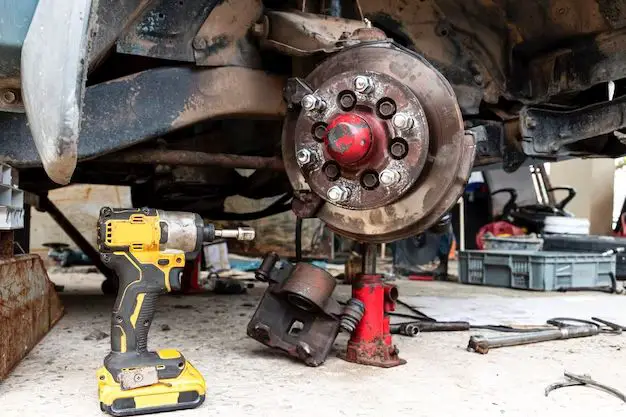Brake dust buildup on wheels is a common problem for many drivers. As brakes wear down from friction, small particles of dust are generated and can stick heavily to alloy or steel wheels. While a small amount of dust is normal, excessive buildup looks unsightly and can damage the wheel over time. Removing heavy brake dust buildup requires using the right tools and techniques to break it down without causing swirl marks or other damage to the wheel’s finish.
Page Contents
What causes heavy brake dust buildup?
All brakes produce some dust through normal wear, but certain factors can contribute to excessive dust buildup on wheels:
- Aggressive brake pads – Performance-oriented pads designed for track use often produce more dust.
- Infrequent cleaning – Allowing dust to accumulate for long periods makes it harder to remove.
- Stop-and-go driving – Frequent braking generates more dust than highway cruising.
- Weak wheel seals – Wheels with poor seals allow more dust ingress.
- Wheel and brake design – Some brake and wheel combinations are more prone to dust buildup.
While brake dust is inevitable, keeping on top of regular wheel cleaning can prevent heavy buildup.
Can you just wash heavy brake dust off?
Unfortunately, you cannot just easily wash off heavy brake dust with normal soap and water. The fine particles bond tightly to the wheel’s surface and require agitation to break this grip. Using just a regular hose or bucket wash tends to spread the dust around rather than lifting it off.
Specialty wheel cleaners contain active ingredients like pH-balanced detergents, solvents, and dissolving agents that are designed to break down the brake dust. However, you need the right tools to work these cleaners properly into the dust.
Wheel cleaning tools
Here are some recommended tools for removing stubborn brake dust:
Wheel brushes
Stiff wheel brushes with nylon or brass bristles are ideal for dislodging tightly bonded dust. Brush sizes range from small scrub brushes for lug nuts to larger 4-6 inch detailing brushes that can cover more surface area. Look for brushes with a contoured shape that can adequately reach the inner and outer wheel barrel.
Wheel woolies
For wheels with intricate designs, wheel woolies are useful. These cylindrical brushes feature a soft wool head that can snake into tight spokes and crevices. Different sizes are available depending on wheel width.
Wheel wash mitt
A dedicated wheel wash mitt provides safe scrubbing ability for the wheel face and rim. Choose microfiber material that is smooth and non-abrasive.
Pressure washer
A gas or electric pressure washer delivers a strong stream of water that can blast off loosened dust. Use the right tips and keep the nozzle 6-12 inches away from the wheel to avoid damage.
Steam cleaner
Heated steam loosens and melts away brake dust for a deep clean. Steam can reach into lug nuts and other tight areas.
| Tool | Description | Use |
|---|---|---|
| Wheel brush | Stiff nylon or brass bristles | Scrubbing wheel face and barrel |
| Wheel woolies | Cylindrical wool brush | Cleaning inside tight wheel spokes |
| Wheel wash mitt | Microfiber mitt | Safe scrubbing of wheel face |
| Pressure washer | High pressure water stream | Blasting off loose dust |
| Steam cleaner | Heated steam | Melting and loosening dust |
Wheel cleaning process
Follow these steps to safely remove heavy brake dust from your wheels:
Rinse wheels
Use a pressure washer or hose to rinse away any loose surface dust. This prevents scratching the wheel when dry cleaning.
Apply wheel cleaner
Spray an acidic, alkaline or solvent-based wheel cleaner onto the wheels according to the product directions. Allow it to soak in for 1-5 minutes. This helps break the dust’s bond.
Agitate with brushes
Use wheel brushes and woolies to scrub the entire wheel surface to dissolve and lift dust. Pay attention to inner and outer barrels.
Wheel face cleaning
Use a dedicated wash mitt or sponge with the cleaner to wipe the wheel face. Turn mitts frequently to expose clean sides.
Second application
For extremely heavy dust, do a second cleaner application and scrubbing.
Rinse well
Thoroughly rinse all cleaner residue off the wheels with a pressure washer or hose.
Follow up cleaning
Use a separate wash bucket and mitt with car soap to give wheels a final clean rinse.
Tips for brake dust prevention
While regular cleaning is key, you can also take some measures to minimize brake dust buildup:
- Choose low-dust brake pads – Ceramic and semi-metallic pads produce less dust.
- Consider dustless rotors – Coatings can minimize dust generation from rotors.
- Improve wheel seals – Well-sealed wheels resist dust ingress.
- Wash wheels regularly – Monthly washings prevent heavy buildup.
- Seal the wheels – Protective wheel waxes and sealants make dust easier to clean.
- Detail interior wheels – Use wheel woolies to clean dust from inside barrels.
Keeping on top of regular wheel washing and using the right tools and cleaners for the job will help you effectively remove heavy brake dust buildup for a clean set of wheels.
Conclusion
Heavy brake dust buildup occurs when regular cleaning is neglected, allowing dust particles to bond tightly to wheels. Specialized acidic or alkaline wheel cleaners combined with the use of detailing brushes, wheel woolies and pressure washing can safely break down and remove bonded dust without damaging wheel finishes. Preventative steps like choosing low-dust brake components, washing wheels frequently and sealing the wheels can also minimize brake dust buildup over time. Consistently using the right tools and techniques will keep your wheels looking their best.
